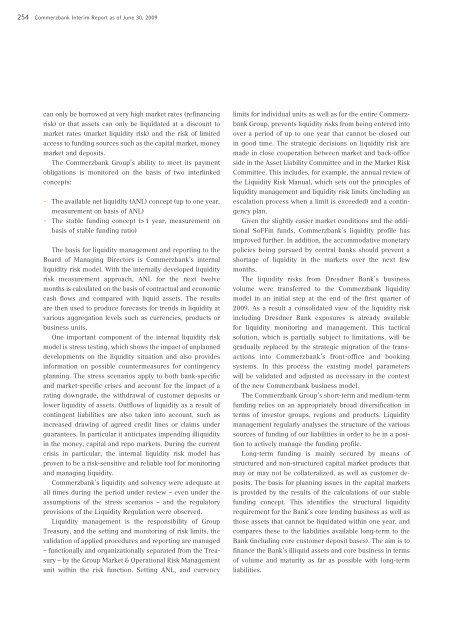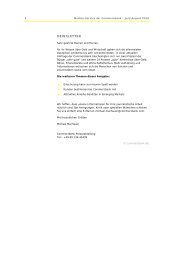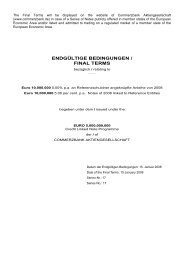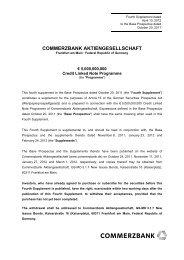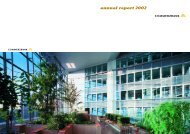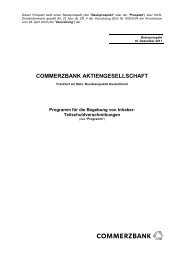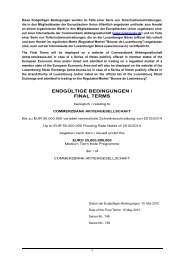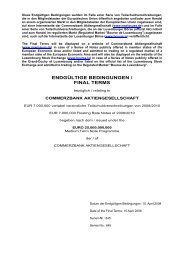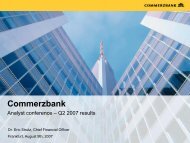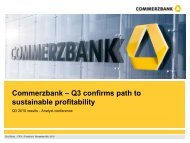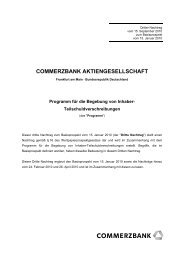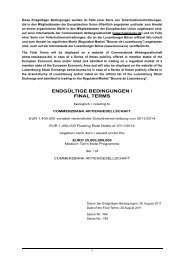COMMERZBANK AKTIENGESELLSCHAFT
COMMERZBANK AKTIENGESELLSCHAFT
COMMERZBANK AKTIENGESELLSCHAFT
You also want an ePaper? Increase the reach of your titles
YUMPU automatically turns print PDFs into web optimized ePapers that Google loves.
254 Commerzbank Interim Report as of June 30, 2009<br />
can only be borrowed at very high market rates (refinancing<br />
risk) or that assets can only be liquidated at a discount to<br />
market rates (market liquidity risk) and the risk of limited<br />
access to funding sources such as the capital market, money<br />
market and deposits.<br />
The Commerzbank Group’s ability to meet its payment<br />
obligations is monitored on the basis of two interlinked<br />
concepts:<br />
• The available net liquidity (ANL) concept (up to one year,<br />
measurement on basis of ANL)<br />
• The stable funding concept (> 1 year, measurement on<br />
basis of stable funding ratio)<br />
The basis for liquidity management and reporting to the<br />
Board of Managing Directors is Commerzbank’s internal<br />
liquidity risk model. With the internally developed liquidity<br />
risk measurement approach, ANL for the next twelve<br />
months is calculated on the basis of contractual and economic<br />
cash flows and compared with liquid assets. The results<br />
are then used to produce forecasts for trends in liquidity at<br />
various aggregation levels such as currencies, products or<br />
business units.<br />
One important component of the internal liquidity risk<br />
model is stress testing, which shows the impact of unplanned<br />
developments on the liquidity situation and also provides<br />
information on possible countermeasures for contingency<br />
planning. The stress scenarios apply to both bank-specific<br />
and market-specific crises and account for the impact of a<br />
rating downgrade, the withdrawal of customer deposits or<br />
lower liquidity of assets. Outflows of liquidity as a result of<br />
contingent liabilities are also taken into account, such as<br />
increased drawing of agreed credit lines or claims under<br />
guarantees. In particular it anticipates impending illiquidity<br />
in the money, capital and repo markets. During the current<br />
crisis in particular, the internal liquidity risk model has<br />
proven to be a risk-sensitive and reliable tool for monitoring<br />
and managing liquidity.<br />
Commerzbank’s liquidity and solvency were adequate at<br />
all times during the period under review – even under the<br />
assumptions of the stress scenarios – and the regulatory<br />
provisions of the Liquidity Regulation were observed.<br />
Liquidity management is the responsibility of Group<br />
Treasury, and the setting and monitoring of risk limits, the<br />
validation of applied procedures and reporting are managed<br />
– functionally and organizationally separated from the Treasury<br />
– by the Group Market & Operational Risk Management<br />
unit within the risk function. Setting ANL, and currency<br />
limits for individual units as well as for the entire Commerzbank<br />
Group, prevents liquidity risks from being entered into<br />
over a period of up to one year that cannot be closed out<br />
in good time. The strategic decisions on liquidity risk are<br />
made in close cooperation between market and back-office<br />
side in the Asset Liability Committee and in the Market Risk<br />
Committee. This includes, for example, the annual review of<br />
the Liquidity Risk Manual, which sets out the principles of<br />
liquidity management and liquidity risk limits (including an<br />
escalation process when a limit is exceeded) and a contingency<br />
plan.<br />
Given the slightly easier market conditions and the additional<br />
SoFFin funds, Commerzbank’s liquidity profile has<br />
improved further. In addition, the accommodative monetary<br />
policies being pursued by central banks should prevent a<br />
shortage of liquidity in the markets over the next few<br />
months.<br />
The liquidity risks from Dresdner Bank’s business<br />
volume were transferred to the Commerzbank liquidity<br />
model in an initial step at the end of the first quarter of<br />
2009. As a result a consolidated view of the liquidity risk<br />
including Dresdner Bank exposures is already available<br />
for liquidity monitoring and management. This tactical<br />
solution, which is partially subject to limitations, will be<br />
gradually replaced by the strategic migration of the transactions<br />
into Commerzbank’s front-office and booking<br />
systems. In this process the existing model parameters<br />
will be validated and adjusted as necessary in the context<br />
of the new Commerzbank business model.<br />
The Commerzbank Group’s short-term and medium-term<br />
funding relies on an appropriately broad diversification in<br />
terms of investor groups, regions and products. Liquidity<br />
management regularly analyses the structure of the various<br />
sources of funding of our liabilities in order to be in a position<br />
to actively manage the funding profile.<br />
Long-term funding is mainly secured by means of<br />
structured and non-structured capital market products that<br />
may or may not be collateralized, as well as customer deposits.<br />
The basis for planning issues in the capital markets<br />
is provided by the results of the calculations of our stable<br />
funding concept. This identifies the structural liquidity<br />
requirement for the Bank’s core lending business as well as<br />
those assets that cannot be liquidated within one year, and<br />
compares these to the liabilities available long-term to the<br />
Bank (including core customer deposit bases). The aim is to<br />
finance the Bank’s illiquid assets and core business in terms<br />
of volume and maturity as far as possible with long-term<br />
liabilities.


